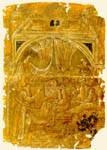|
|
| Anthivola |
16th c. Dionysiou Monastery Grisaille on paper, 31.5 x 22 cm |
|

|
This is a very fine work of art from the early sixteenth century. Even without the rich colours of the model or final painting, the control of line and attention to detail attest to the creative ability of the artist. The theme is the Washing of the Feet, a scene taken from the Dodekaorton, which takes place in a domed structure. The paper has been damaged around the edge, and in the middle by a horizontal crease. The painter used ochre on which he successfully rendered all the details of his subject with limited use of black - mostly in the outlines - and white in various tones. Christ stands on the left, His right hand raised didactically and his left resting on the rim of the basin. A towel is tied around his waist as described in the Gospel of John (13:4) and he is leaning slightly forward with his left leg bent. On a bench in front of Christ sits Peter, whose legs, one in the water and one out, are exposed to the knee, and who has brought his right hand to his head. The other disciples are portrayed in a group behind Peter, with the exception of Judas, who is seated apart, in front of the bench, conversing with the devil. The theme is completed with the building which the artist clearly executed with great care: two columns in the foreground support an arched opening, and two canopies supported by columns and a dome with a double opening adorn the flat roof. Two curtains hang from the arch and are draped over elaborate supports at the springers. The Washing of the Feet appears, with variation of detail, in both the monumental painting and the icons and manuscripts of the Byzantine period (Millet 1960, p. 312). Christ is usually shown drying Peter's feet (Acheimastou-Potamianou 1983, pp. 72-3), but there are also examples in which Christ is teaching while Peter has one or both feet in the water (Millet 1960, pp. 316-17. Vocotopoulos 1995, pp. 193-4). In this anthivolon, Christ is shown for the first time, to the best of my knowledge, resting his left hand in the rim of the basin. Also unusual is Judas conversing with the devil in this scene. The earliest examples in monumental art date from the second half of the sixteenth century, though earlier examples can be found in illuminated manuscripts (Tourta 1991, p. 99). The precise rendering of all the details in this work leaves no room for doubt that it is not an artist's anthivolon or working drawing, as in the case of the Revelation scene or the Tree of Jesse from the same monastery (Vassilaki 1995, p. 41). It is clear that here the artist wished to present a complete sample of his work either to gain a commission or for his own use, as in the case of the grisaille of the head of St Athanasios the Athonite (no. 3.1)
| |
|
Bibliography: Unpublished.
| ||
| I.T. | ||
| Index of exhibits of Monastery of Dionysiou 16th century |
||
Reference address : https://www.elpenor.org/athos/en/e218ac2.asp